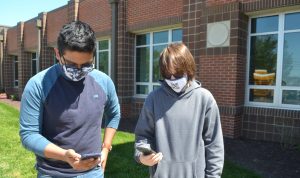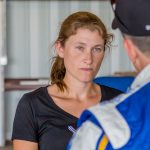
BERLIN – Two local teenagers worked together to solve a problem that’s been frustrating cell phone users since the pandemic began.
While anyone who uses facial recognition to unlock their cell phone knows face masks have stymied the practice, most simply noted the inconvenience and moved on. Worcester Technical High School students Myra Cropper and Daniel Juarez decided to solve the problem.
“This a problem I personally complained about and heard other people expressing frustration about…,” Worcester Tech teacher Valerie Zienty said. “Isn’t it amazing that high schoolers solved a problem that is bothering people nation/world-wide?”
Juarez, a senior, said he was riding his bike one day when he got a call on his cell phone.
“I tried opening it and couldn’t because of my mask,” he said.
That got him thinking about what it would take to get his phone to unlock for him when he was wearing a mask. Juarez initially considered adding a chip to his face mask but quickly realized that wouldn’t be washable. It was then he turned to the idea of coding and approached Cropper.
“I talked to Myra because she’s good at programming,” he said.
Despite their heavy class loads and after-school programs, the students found some free time to develop a code to recognize a face while it’s wearing a mask.
“The first step was researching different existing code libraries and studying what had already been done to see if I could modify that,” said Cropper, a junior at Worcester Tech.
While Cropper worked on code, Juarez focused on the practical issues. Though their idea was to add a barcode to a mask and have the phone read it, in talking with friends and teachers at Worcester Tech they identified a flaw.
“A lot of people said what happens when someone steals your mask,” Juarez said.
As a result, Cropper modified the code to recognize the top portion of a person’s face as well as the barcode on the mask. Once that was done, they used a teacher’s Cricut machine to print the barcodes onto their masks.
Zienty, who was already impressed when Juarez told her about the extracurricular project, said she was in awe when Cropper showed her how they’d made the concept a reality.
“The first thing I will mention is problem-solving and perseverance,” Zienty said. “Daniel and Myra had a mentor from Salisbury University, but other than that they had to rely on themselves and their research skills to solve problems they encountered while working on this project.”
She believes that is something that will serve them well later in life.
“This skill alone is invaluable in college regardless of the major,” she said.
Juarez and Cropper, who tackled the project simply because they wanted to solve a problem, acknowledged that they’d learned something along the way.
“Time management,” Cropper said.
Juarez agreed and said that while his primary interest is mechanical engineering, this had expanded his skillset.
“It helped familiarize me with coding,” he said.
Zienty praised the students for taking on a challenge. Though Apple in recent weeks released an update that enables iPhones to work with face coverings, her students developed a solution on their own.
“I like how they think about betterment of our society and look for problems to solve,” she said. “Some people think ‘oh that’s inconvenient’ and go on with their lives, but these two students look for ways to address and solve the issue.”

